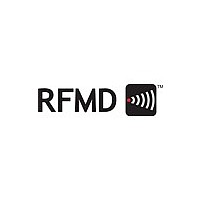Communication receivers are constructed using a
superheterodyne architecture. The received signal fre-
quency is converted to a lower “intermediate” fre-
quency (IF) in one or more steps for efficient
amplification, filtering, and detection. The first down-
converter circuit is often the primary determinant of
overall receiver performance. This circuit typically con-
sists of a band-limiting preselector filter (which may
actually be the receive path of a duplexer), a low-noise
amplifier (LNA), an image filter, a mixer, and a local
oscillator.
The RF2411 is a monolithic integrated circuit UHF
receiver downconverter which implements all of the RF
functions of the required circuitry except passive filters
and local oscillator in a 14-lead small outline plastic
package. The block diagram of the device is included in
Figure 1. It is suitable for general application in the
500MHz to 1900MHz frequency range, at power sup-
ply voltages from 3V to 6V. Its high level of perfor-
mance with a minimum of external components is a
direct result of the advanced heterojunction bipolar
transistor (HBT) IC process used. Broadband imped-
ance matching at the RF ports and flexible IF interface
simplify application to many receiver systems.
The LNA achieves broadband impedance match to
50Ω and low noise figure through internal feedback cir-
cuitry, not by use of external components. Input return
loss is greater than 20dB and output return loss is
greater than 10dB over the entire 1MHz to 1500MHz
range. LNA gain slopes from 17dB at 1MHz to 11dB at
Figure 1: RF2411 Functional Block Diagram
IF OUT+
IF OUT-
LNA IN
GND
GND
GND
GND
1
2
3
4
5
6
7
MIXER
RF AMP
LNA
Copyright 1997-2002 RF Micro Devices, Inc.
14
13
12
11
10
9
8
LNA OUT
NC
VCC1
VCC2
RF IN-
RF IN+
LO IN
TA0026
The RF2411 General Purpose UHF Downconverter IC
1500MHz, as plotted in Figure 2. LNA reverse isolation
is high over a the full frequency range, decreasing from
24dB at 1MHz to 21dB at 1500MHz. Noise figure is
low and almost flat, increasing from 1.7dB at 500MHz
to 2.4dB at 1500MHz, as plotted in Figure 3.
There is a dependence of LNA noise figure, gain, and
IIP3 on power supply voltage at 880MHz. Gain can be
seen to decrease from 14.6dB to 11.8dB as V
reduced from 5V to 2.5V. IIP3 decreases from
-1.75dBm to -11.6dBm, and noise figure decreases
slightly from 1.88dB to 1.7dB over the same supply
voltage range.
Figure 3: Noise Figure vs. Frequency
Figure 2: LNA Gain and Reverse Isolation vs.
Frequency
2.5
1.5
0.5
3
2
1
0
500
600
700
800
Frequency (MHz)
RF2411 LNA Noise Figure
900
1000
Vcc = 5V
1100
TA0026
1200
1300
1400
1500
15-121
CC
is
15













